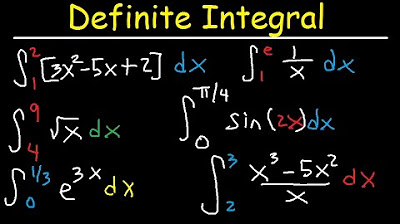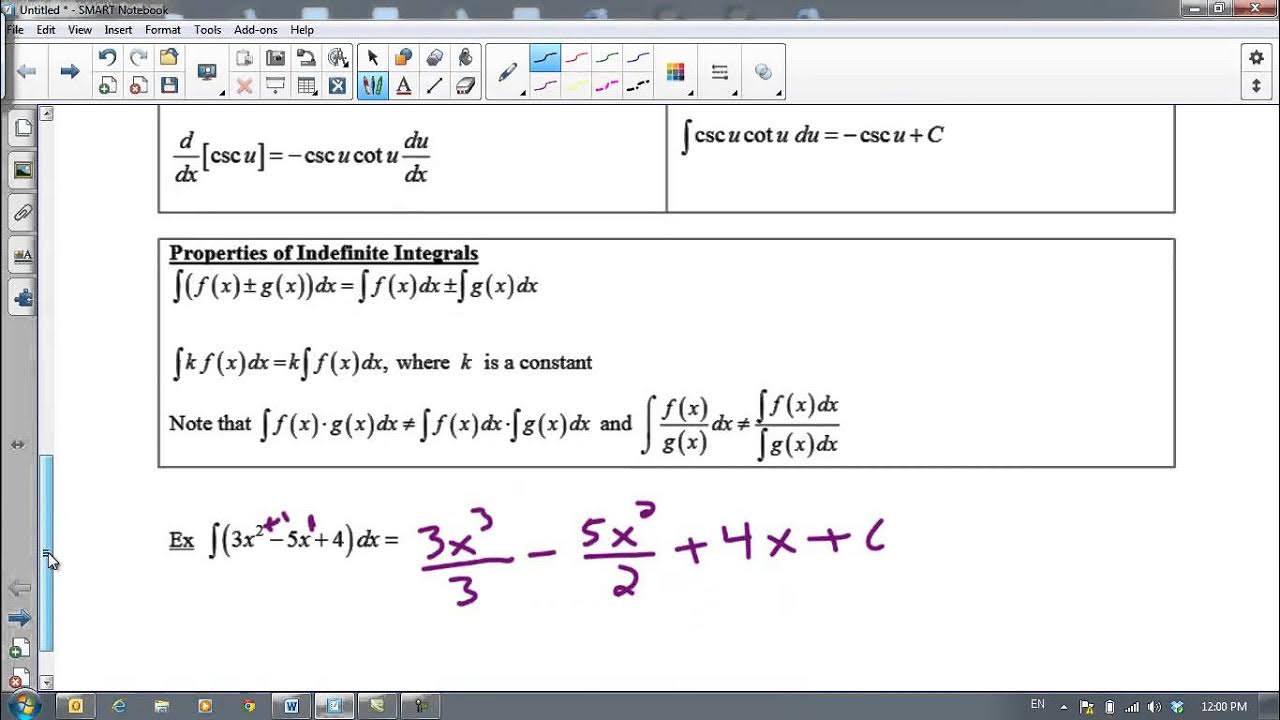Antiderivatives
TLDRThis video script offers a comprehensive guide on finding the antiderivative of a function, explaining the concept as the opposite of differentiation. It distinguishes between indefinite and definite integrals, outlines the process of integration, and provides examples of finding antiderivatives for various functions. The script also introduces techniques for integrating rational functions and emphasizes the importance of the constant of integration, with a focus on understanding the difference between constants and variables in integration.
Takeaways
- 📚 The antiderivative is the opposite of differentiation, with the derivative being the rate of change and the antiderivative representing the reverse process.
- 🌟 The antiderivative of a function f(x) is denoted as ∫f(x)dx or F(x), where F(x) is the integral function.
- 🔄 The process of finding the antiderivative is called integration, while finding the derivative is called differentiation.
- 📈 There are two types of integrals: indefinite integrals, which result in a function plus a constant (F(x) + C), and definite integrals, which result in a numerical value.
- 🔢 The indefinite integral symbol (∫) is used to represent the antiderivative, while the definite integral is represented with limits of integration (lower and upper bounds).
- 🎯 To find the antiderivative of a variable raised to a constant, you add 1 to the exponent and divide by the new exponent, plus the constant of integration (C).
- 📊 The power rule for derivatives can be inverted to find antiderivatives: the antiderivative of x^n is (x^(n+1))/(n+1) + C.
- 🌐 Integration by parts or substitution may be required for more complex functions, such as those involving rational functions or trigonometric expressions.
- 📝 The constant of integration (C) is necessary for indefinite integrals but is not included in the result of definite integrals.
- 🔍 The derivative of the natural logarithm function (ln x) is 1/x, which means the antiderivative of 1/x is ln|x| + C.
- 🚀 Successive integration may be needed when given a higher-order derivative, requiring the integration of the function multiple times to find the original function.
Q & A
What is the antiderivative of a function?
-The antiderivative of a function, also known as the integral, is the reverse process of differentiation. It represents the function that, when differentiated, yields the original function. Mathematically, if f'(x) is the derivative of f(x), then F(x) is the antiderivative of f(x) such that F'(x) = f(x).
How is the antiderivative related to the derivative?
-The antiderivative and the derivative are inverse operations. The antiderivative of a function f(x) is a function F(x) such that F'(x) = f(x). Conversely, if you differentiate the antiderivative F(x), you get back the original function f(x).
What is the difference between an indefinite integral and a definite integral?
-An indefinite integral provides a family of functions, typically expressed in terms of x, and includes the constant of integration. A definite integral, on the other hand, gives a specific numerical value. The key difference is that a definite integral has limits of integration (lower and upper bounds), while an indefinite integral does not.
How do you find the antiderivative of a function raised to a constant?
-To find the antiderivative of a function f(x) raised to a constant n, you increase the exponent by 1 and divide by the new exponent, then add the constant of integration (c). So, the antiderivative of f(x)^n is (f(x))^(n+1)/(n+1) + c.
What is the process of finding the antiderivative called?
-The process of finding the antiderivative is called integration. It is the mathematical operation that reverses the process of differentiation.
What is the antiderivative of x cubed?
-The antiderivative of x cubed (x^3) is (x^4)/4 + c, where c is the constant of integration.
How do you find the antiderivative of a sum of functions?
-To find the antiderivative of a sum of functions, you integrate each function separately and then add the results. For example, the antiderivative of f(x) + g(x) is F(x) + G(x), where F(x) is the antiderivative of f(x) and G(x) is the antiderivative of g(x).
What is the general formula for integrating rational functions of the form 1/(ax + b)?
-The general formula for integrating rational functions of the form 1/(ax + b) is ln|ax + b| + c, where a and b are constants, and c is the constant of integration.
How do you find the antiderivative of 1/x?
-The antiderivative of 1/x is ln|x| + c, where c is the constant of integration. This is a standard result that should be memorized as it cannot be derived using the power rule for integration.
What is the antiderivative of a constant?
-The antiderivative of a constant c is cx + c, where x is the variable of integration and c is the constant of integration. Essentially, you multiply the constant by the integration variable and add the constant of integration.
How do you verify that an antiderivative is correct?
-To verify that an antiderivative is correct, you differentiate the proposed antiderivative and check if it equals the original function. If the derivative of the antiderivative matches the original function, then the antiderivative is correct.
Outlines
📚 Introduction to Antiderivatives
This paragraph introduces the concept of antiderivatives, explaining that they are the opposite of derivatives in calculus. It defines the antiderivative as the integral of a function and contrasts it with the derivative. The paragraph also distinguishes between indefinite and definite integrals, using examples to illustrate the differences. The process of finding antiderivatives is described as integration, while finding derivatives is called differentiation.
🧮 Derivative and Antiderivative Relationships
The paragraph delves into the relationship between derivatives and antiderivatives, using the power rule as an example. It explains how to find the antiderivative of a variable raised to a constant by adding 1 to the exponent and dividing by the new exponent. The constant of integration is introduced, and its relevance in indefinite integrals is discussed. The paragraph also provides a step-by-step process for finding the antiderivative of a function, such as 3x^2, and emphasizes the importance of adding the constant of integration.
📈 Solving Integration Problems
This section focuses on solving integration problems by applying the rules learned in the previous paragraphs. It guides the viewer through finding the antiderivative of various functions, including polynomials and constants. The process involves adding one to the exponent of the variable, dividing by the new exponent, and adding the constant of integration. The paragraph also discusses the difference between indefinite and definite integrals in the context of solving problems.
🌟 Successive Integration and Special Cases
The paragraph discusses the concept of successive integration, where a function is integrated more than once. It provides an example of finding the antiderivative of a function's derivative, emphasizing the need to integrate twice to find the original function. The paragraph also covers special cases, such as integrating constants and variables, and explains how to treat them during integration. The process of integrating rational functions is introduced, with a focus on moving the variable to the numerator and using the power rule.
📚 Integration of Rational Functions and Constants
This paragraph focuses on integrating rational functions and constants. It explains the process of integrating a constant, such as pi or e, by treating them as constants and integrating with respect to the variable. The paragraph then moves on to integrating rational functions, where the variable is moved from the denominator to the numerator, and the power rule is applied. The process is demonstrated with examples, and the importance of distinguishing between constants and variables is highlighted.
🔢 Advanced Integration Techniques
The paragraph presents advanced integration techniques for rational functions, particularly when the denominator is a linear function. It introduces a general formula for integrating functions of the form 1/(ax + b) and explains the conditions under which this formula can be used. The paragraph also provides examples of integrating more complex rational functions and demonstrates how to handle cases where the derivative of the function results in a linear expression. The process of finding the antiderivative of 1/x is discussed, along with the antiderivative of 1/(x + c) for various constants.
🎓 Verifying Integration Techniques
The final paragraph is dedicated to verifying the integration techniques learned throughout the script. It demonstrates how to confirm the correctness of the integration process by differentiating the antiderivative to recover the original function. The paragraph provides examples of verifying the integration of linear functions and those involving constants, reinforcing the understanding of integration and differentiation as inverse processes.
Mindmap
Keywords
💡Antiderivative
💡Differentiation
💡Integral
💡Indefinite Integral
💡Definite Integral
💡Constant of Integration
💡Power Rule
💡Integration
💡Successive Integration
💡Rational Functions
Highlights
The antiderivative is the opposite of differentiation, with the derivative of f(x) being f'(x), and the antiderivative of f'(x) being f(x).
The integral of a function, denoted as ∫f(x) dx, represents the antiderivative of the function.
The process of finding the antiderivative is integration, while the process of finding the derivative is differentiation.
An indefinite integral gives you a function in terms of x (or another variable), whereas a definite integral gives you a number.
The antiderivative of a variable raised to a constant is the variable raised to the constant plus 1, divided by the constant plus 1, plus the constant of integration (c).
To find the antiderivative of a function, you add 1 to the exponent of the function, divide by the new exponent, and include the constant of integration (c).
The antiderivative of x^3 - 4x^2 + 8x is 1/4 * x^4 - 4/3 * x^3 + 4x^2 + c.
Given the first derivative of a function, you can find the antiderivative by integrating the derivative expression.
The antiderivative of 8x^3 - 6x^2 + 4x - 7 is 2x^4 - 2x^3 + 2x^2 - 7x + c.
Integration of constants involves adding the variable (dx, dy, dz, etc.) to the constant.
The indefinite integral of rational functions involves moving the variable to the top of the fraction and integrating accordingly.
The indefinite integral of 1/x is ln|x|, which is a special case to remember for integrating functions where the denominator is a linear function of x.
The antiderivative of functions with denominators in the form of ax + b can be found using the formula 1/u * ln(ax + b) + c, where u is a linear function of x.
The indefinite integral of 1/(3x + 4) is 1/3 * ln(|3x + 4|) + c, demonstrating the application of the formula for integrating linear denominators.
The derivative of ln(3x + 4)/3 confirms the correctness of the integration process, as it simplifies back to the original function 1/(3x + 4).
The indefinite integral of 1/(x + 7) is ln(|x + 7|) + c, another example of integrating a function with a linear denominator.
For rational functions where the denominator is a linear function, the integration process involves separating constants and integrating each term individually.
The indefinite integral of 5x^7 - 9x^2 + 4x - 8 is 5x^8/8 + 9x^(-1) - 4x^2 + c, showcasing the integration of polynomial functions.
The antiderivative of 1/x + 3 is ln|x + 3|, illustrating the integration of functions with constants in the denominator.
The antiderivative of 5/x + 2 is 5ln|x + 2| + c, demonstrating the integration of rational functions with added constants.
The antiderivative of 7/x + 4 is 7ln|x + 4| + c, showing how to integrate rational functions with constants in the numerator and denominator.
Transcripts
5.0 / 5 (0 votes)
Thanks for rating:





